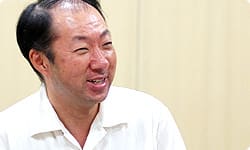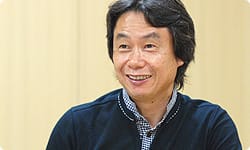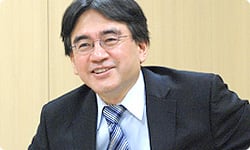To Save Memory
Kondo-san, what did you seek to do when you first started making the music for Super Mario Bros.? When it comes to Super Mario Bros., a lot of people think of the aboveground background music . How did that song come about?
I'd been playing the game ever since the experimental stages. I remember it made a strong impact on me when I first saw the Super Mario Bros. prototype and the player-character moving around in it was bigger than any I'd ever seen before.
Mario when he becomes Super Mario.
Actually, the normal-sized Mario didn't exist in the first prototype.
That's right. Having a big player-character was one theme that we focused on as we began experimenting. Did you start working on the sound at a fairly early stage?
Yes.
A lot of the time during the early days of the Famicom, you wouldn't be told to put in the sound until about a month before completion.
Yeah, that's right.
But it wasn't like that for Super Mario Bros.
If we put in the sound later, the CPU would get eaten up, which could pose a big problem. So we decided to put some sound into the prototype, even if it was temporary.
Oh, that's right. You do use the CPU to generate sound, so when you put in sound back then, sometimes the CPU, which was just barely keeping up, wouldn't be able to keep up anymore. Super Mario Bros. was a grand culmination of previous games, so we had to be thoroughly prepared when it came to the sound as well.
That's how we handled the sound.
So I started in on the music, but the first song I finished wasn't the aboveground BGM.
(reading the specifications) The notes for the aboveground BGM say, "Above ground, Western-sounding, percussion and a sound like a whip." That isn't at all like the actual song! (laughs)
(laughs)
But it also says to make above ground sound fun, which is accurate. And it says the music should be a little dark underground and have bubbly sounds under the water.
It was easy to imagine what the underwater BGM should be like. That was easy to make, so it was the first song I finished. Then I made the aboveground BGM, and like I said in the session of "Iwata Asks" over Super Mario All-Stars, the first version I made didn't go over well at all.
The first version you made was easygoing, so you scrapped it.
Right. I tried to match it to the blue sky and greenery in the background, but it didn't match the rhythm of Mario's running and jumping, so people said it didn't feel right.
At first, you made the music to match the way the game looked.
That's right. Then, when I actually played the prototype, I made the current song.
I did say something wasn't right about the first song, but we settled on the next one right away.
That's right.
It was perfect.
After you made the second version, did you make any big changes to it?
No. It stayed the way it was.
Perhaps being able to play the prototype so early on was one factor that led to that song.
I think so. I learned the importance of being able to actually play the game and match the music to its rhythms.
I thought the aboveground BGM was good, but when he made the underground BGM, it was an even more perfect fit! He made it with sound effects, but it sounded like music. I thought it was really a good thing to be working with someone who specialized in music. I was really happy about it.
Um...
Yes?
I don't remember Miyamoto-san ever really praising me at the time, so I feel like that's the first time it ever happened. I'm so happy. (laughs)
(laughs)
After 25 years, he finally praised you. (laughs) Miyamoto-san, I feel like maybe you should compliment him a little more. (laughs)
Well, he turned out all right. (laughs) But actually, I just complimented you recently. I said the athletic music from Super Mario World 2: Yoshi's Island14 was good.
Yeah. (laughs)
(laughs) So it's not just once every 25 years.
I praised him about two times last week!
(laughs) 14. Super Mario World 2: Yoshi's Island: An action game released for the Super Famicom system in August 1995.
I'd like to ask about the sound effects, too. Did you immediately hit on the sound for Mario getting bigger?
I poked around a bit for that, too. It's not a sound you can figure out just by thinking about it in your head.
I've never heard any other sound quite like it. It's a distinctive sound that sticks with you.
Yeah.
Did we give you examples of what kind of sound to make?
I don't think you gave me any instructions like that.
Did we suggest anything like (going up a scale) ♪dumm...dumm...dumm...dumm, or a fanfare like ♪dum-da-da-dummm?
No, no. (laughs) I think you just told me to make a sound effect for when Mario got bigger.
I thought so.
(laughs)
Mario sort of flashes as he gets bigger, so I made that sound effect to match. And to save memory, I needed to get a lot of use out of the same sounds. So, for example, I used the same sound for when he gets smaller and when he goes into pipes.
When he goes into pipes, it goes chung-chung-chung. I bet you hadn't noticed they were the same.
Oh, I guess they are.
And the bwip! sounds when he steps on turtles and swims are the same.
They seemed different in my head, but I guess they're the same!
That was all to save memory.
Thanks to that, I'd be overjoyed and say, "Now I can put in three more blocks!" (laughs)



